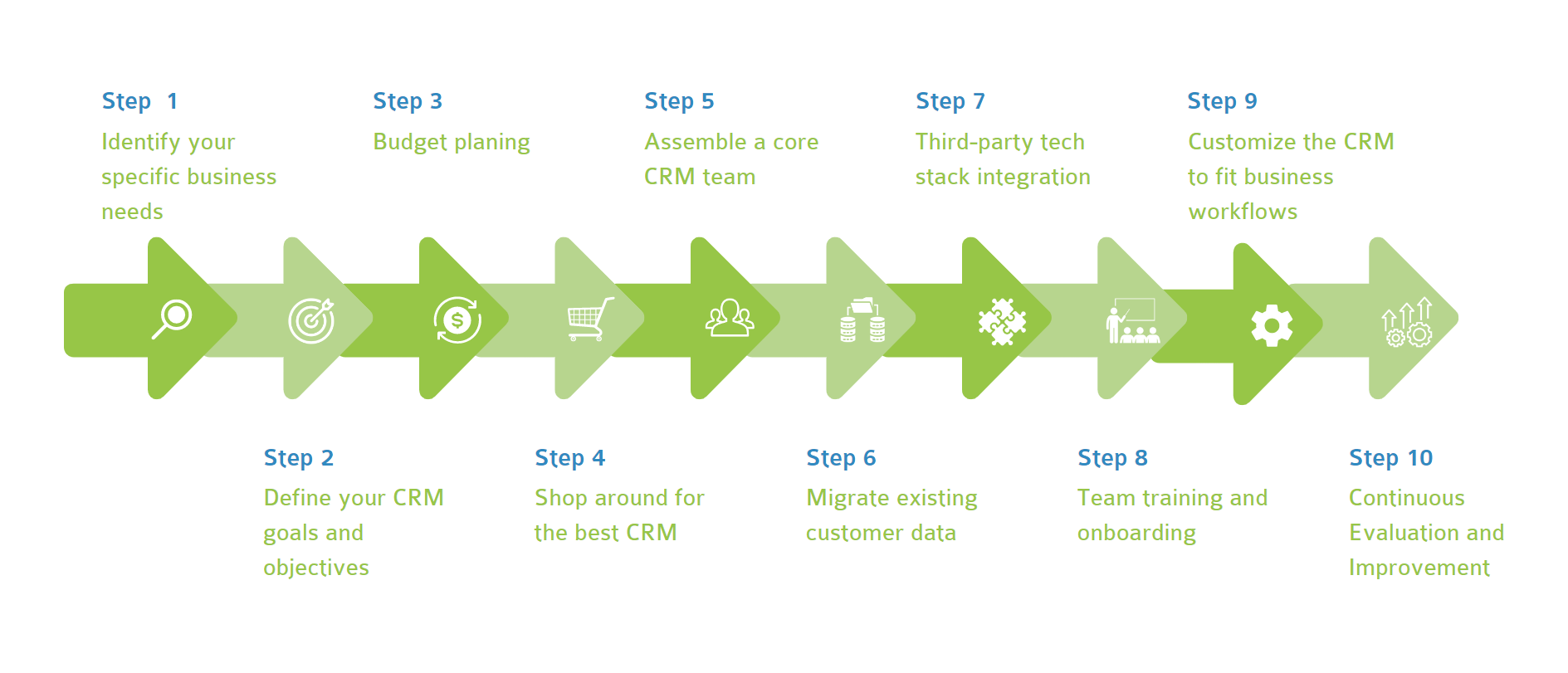10 Essential Steps for a Successful CRM Implementation
The complete guided plan for a successful CRM implementation
November 24, 2022 | Read time: 8 min
The success of your business stands more in the strategy you adopt than in the technology you choose.
Based on this statement we can say that a CRM (Customer Relationship Management) system is far more than a set of tools.
Customer relationship management (CRM) solutions help companies of all sizes drive business growth. CRM software* has evolved from a tool that just sustains sales teams in storing customer data to a performant system that brings the most valuable insights into the buyer’s preferences. It provides a personalized approach in the digital age we live in. It aligns clients, businesses, employees, and technology into a technology that helps you understand the market, industry, and customer drivers.
CRM solutions add a lot of value to your organization, but it all comes down to how well you integrate them with your business processes. The best implementation strategy starts with discovering your needs, setting goals, budget planning, and CRM acquisition, assigning a team to oversee the implementation, measuring your success, and fine-tuning the strategy.
Whether you're replacing CRM or you’re a first-time user, your CRM strategy is critical.


Step 1: Identify the specific business needs
The first and most important step in CRM implementation is discovering your specific business needs. Make a list of requirements across departments and match them to a clear objective for the CRM implementation. For example, do you want to acquire more leads, or maybe you want to increase your revenue?
Next, map out all the sales and marketing processes inside your business, and every source of leads. Then, list the sales and marketing processes you expect to streamline with the CRM. For example, if you struggle with creating monthly sales reports, seek sales reporting functionality. This should give you an overview of your sales organization to sustain with the CRM, and the features you need the most from the software.

Step 2: Define your CRM goals and objectives
Once you have your business needs, translate them into CRM goals and objectives. It’s important to remain realistic, a CRM, no matter how powerful, won’t be able to double your revenue without a clear strategy and a solid action plan. We propose a SMART goal a CRM can help your business achieve like - Increasing weekly incoming leads to 35% by the end of the year. Create your own goals, relevant to your specific business situation.

Step 3: Plan the budget for your CRM implementation
When planning your budget, think of both CRM implementation and subscription fees. Some providers use a subscription-based pricing model and offer different features in different pricing formulas. Most of the time, if your business aims to scale, the basic plan won’t be enough, and you’ll end up needing features that aren’t included in the cheapest plan and you’ll have to pay extra. We recommend making a list of features so you know what you need from the start. Also, integrations can either be a cost-saving or a great cost if you don’t also consider them first.

Step 4: Shop around for the best CRM
CRM providers might offer many and varied feature packs, that’s why you must write down the features you absolutely need in a CRM. Analyze features, compare pricing models, and read outside reviews. You must compare everything up to customer support and service. Remember that the solutions offered should be easily integrated with all departments in your company.

Step 5: Assemble a core CRM team
When planning your budget, think of both CRM implementation and subscription fees. Some providers use a subscription-based pricing model and offer different features in different pricing formulas. Most of the time, if your business aims to scale, the basic plan won’t be enough, and you’ll end up needing features that aren’t included in the cheapest plan and you’ll have to pay extra. We recommend making a list of features so you know what you need from the start. Also, integrations can either be a cost-saving or a great cost if you don’t also consider them first.

Step 6: Migrate existing customer data
This step can either be performed manually or using data migration tools. That data can come from a previous CRM platform, a lead management tool, a series of spreadsheets, or the previous CMS.

Step 7: Third-party tech stack integration
For the seamless working of the CRM software, it’s time to connect all the other tools your team uses to the shiny new CRM system, from lead generation and website tools to analytics or maybe project management tools.

Step 8: Team training and onboarding
After the CRM system is ready, it’s time to get people to use it, and building a comprehensive onboarding and training plan is critical.
CRM is something people often overlook, and you must give your team ample time to get to know the software. Also, allow some downtime from their regular work tasks. There will also be holdouts who don’t like new things. If you communicate clearly how CRM is a tool that helps their work, not add to it, they will be less reluctant.

Step 9: Customize the CRM to fit business workflows
Based on all the processes outlined in your CRM implementation plan, you need to customize your system to fit your workflows. This includes the ability to automate manual tasks (touchpoints in the sales process) and to integrate with the other tools you’re already using (email marketing tools you use to nurture prospects throughout the customer journey). Other customizations include: setting the CRM dashboard, creating the sales pipeline, and setting customized reports.

Step 10: Constantly evaluate and improve
Finally, it’s time to take a step back and measure the success of your CRM implementation. In order to do that, measure your success rates against the goals and objectives you outlined at step 2. Remain agile to your shifting business needs, benchmark your CRM, hear the concerns of your team and rectify all the CRM mistakes on the way.
Conclusion
Following these 10 steps will help you ensure a successful CRM implementation project. Good luck!
If you feel you don’t have the internal resources to take on a well-invested CRM approach, since it involves a significant amount of time and resources, work with an independent CRM consultancy company**. We are here to support you through your CRM implementation journey, from selecting the most appropriate CRM solution, to ongoing maintenance and support to keep things running smoothly.
Secondary Reference Sources
Our Services



